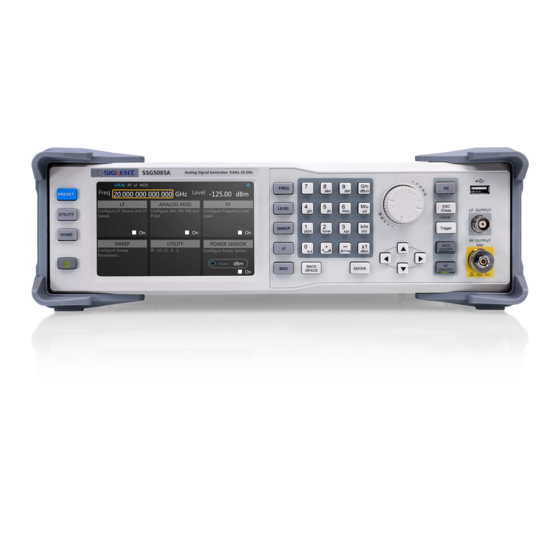
Summarization of Contents
Guaranty and Declaration
Copyright and Trademark
Covers legal rights, ownership, and registered trademarks of SIGLENT products and publications.
Declaration and Product Certification
Outlines product protection, modification rights, publication replacement policy, and certifications.
General Safety Summary
Power and Grounding Precautions
Instructions for using the correct power cord and ensuring proper instrument grounding to prevent shock.
Probe and Terminal Safety
Guidance on connecting probes correctly and checking terminal ratings to avoid hazards.
Overvoltage and Electrostatic Protection
Measures to prevent overvoltage damage and protect against electrostatic discharge during operation.
Ventilation and Component Safety
Importance of proper ventilation and avoiding operation with covers removed for instrument safety.
Environmental and Operational Safety
Precautions regarding fuse usage, surface conditions, wet environments, and explosive atmospheres.
Safety Terms and Symbols
Manual Safety Terms
Definitions of DANGER, WARNING, and CAUTION terms used within the manual.
Instrument Safety Symbols
Explains symbols like Hazardous Voltage, Protective Earth Ground, Warning, and Chassis Ground found on the instrument.
Working Environment
Environmental Specifications
Details operating conditions including voltage, frequency, temperature, humidity, altitude, and pollution degree.
Cleaning Procedure
Instructions for cleaning the instrument exterior using a soft cloth, avoiding moisture and chemicals.
SSG5000A Overview
Features and Benefits
Highlights the product's frequency range, resolution, output level, accuracy, modulation, and interface capabilities.
Chapter 1: Quick Start
Appearance and Dimensions
Provides front, top, and side views with physical dimensions of the instrument.
Preparing for Use
Instructions on adjusting supporting legs and connecting the instrument to AC power.
Front Panel Description
Details of front panel components including function keys, backlight, keyboard, and connectors.
Rear Panel Description
Explains rear panel connectors such as AC power, LAN, USB host/device, EXT MOD, 10MHz, and TRIG.
User Interface Overview
Describes the prompt status bar, RF frequency/level display, and touch screen operation.
Parameter Setting Guide
Demonstrates setting parameters using the digital keyboard, touch screen, and knob.
Help Information Access
Guide on how to access the built-in help system for functions and menus.
Chapter 2: Front Panel Operation
Frequency Configuration
Covers setting RF output frequency, frequency offset, and phase offset.
Level Configuration
Details on setting RF signal level, level offset, ALC state, and flatness correction.
Sweep Configuration
Explains sweep states, pause, step sweep, list sweep, direction, mode, and trigger settings.
Analog Modulation Setup
Guides on Amplitude Modulation (AM), Frequency Modulation (FM), and Phase Modulation (PM) setup.
Pulse Modulation Setup
Instructions for Pulse Modulation (PULSE) including state, output, source, polarity, mode, and trigger.
LF Signal Configuration
Covers LF signal source, state, frequency, level, shape, phase, and sweep settings.
Utility Settings and Functions
Details system settings, interface configuration, self-tests, shutdown, preset, update, options, and help.
Power Sensor Integration
Describes connecting and using USB power sensors for measurement, level control, and statistics.
Shortcut Key Functions
Explains the usage of shortcut keys like PRESET, Home, Trigger, ESC/Close, and MOD/RF ON/OFF.
Chapter 3: Application Examples
Outputting an RF Signal
Step-by-step guide to output an RF signal at a specified frequency and amplitude.
Correcting 10MHz Reference
Procedure for correcting the internal 10MHz reference signal using adjustment functions.
Correcting Line Loss
Method to correct line loss using the flatness function and a power meter.
Outputting a Pulse Train
Guide on configuring the RF source to output a user-defined pulse train sequence.
Chapter 4: Programming Overview
Remote Operation Setup
Instructions for establishing remote control connections via USB, LAN, and GPIB.
Building Communication Links
Steps for installing and using NI-VISA and Sockets/Telnet for instrument communication.
Remote Control Capabilities
Details on using SCPI commands, NI MAX software, and Web Control for remote operation.
Chapter 5: Troubleshooting
General Inspection Procedures
Steps for inspecting shipping container, instrument, and accessories before service.
Common Troubleshooting Scenarios
Addresses issues like no display, unresponsive keys, incorrect output, sweep problems, and USB recognition.
Chapter 6: Service and Support
Service Summary and Warranty
Outlines the product warranty period and terms for repair or replacement.
Contact Information
Provides contact details for SIGLENT sales and support offices worldwide.
















Need help?
Do you have a question about the SSG5083A and is the answer not in the manual?
Questions and answers